Study Guide
Field 110: School Building Leader Part Two
Sample Video Observation and Analysis Assignment 1
School Building Leader Part Two begins with the Video Observation and Analysis. The assignment includes an approximately 15-minute video of a teacher delivering instruction to students. The video clip will play once while you record your observations, focusing on the components in the Teacher Observation Rubric provided. Then you will write a response in which you analyze and evaluate the performance of the teacher shown in the video.
Sample Directions
The first screen when you start Part Two provides the directions for the Video Observation and Analysis Assignment and the Teacher Observation Rubric, as shown below.
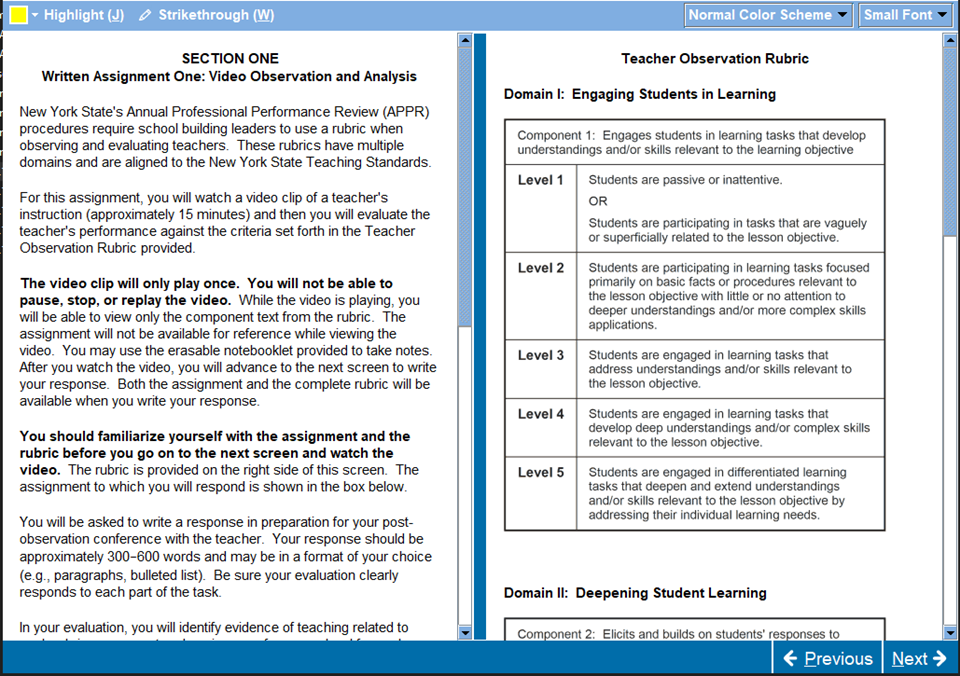 A screenshot from the school building leader Part 2 computer based test with written assignment one video observation and analysis directions on the left side of the screen and domain 1 engaging students in learning, component 1 of the teacher observation rubric on the right side of the screen. The content of both the directions and the rubric will be read below.
A screenshot from the school building leader Part 2 computer based test with written assignment one video observation and analysis directions on the left side of the screen and domain 1 engaging students in learning, component 1 of the teacher observation rubric on the right side of the screen. The content of both the directions and the rubric will be read below.
The directions text presented on the left side of this screen appears below. Please note that at the test center, you will need to use the scroll bar immediately to the right of the text to access the full directions and boxed writing assignment.
New York State's Annual Professional Performance Review ( A P P R ) procedures require school building leaders to use a rubric when observing and evaluating teachers. These rubrics have multiple domains and are aligned to the New York State Teaching Standards.
For this assignment, you will watch a 15-minute video clip of a teacher's instruction and then you will evaluate the teacher's performance against the criteria set forth in the Teacher Observation Rubric provided.
The video clip will only play once. You will not be able to pause, stop, or replay the video. While the video is playing, you will be able to view only the component text from the rubric. You will be provided with a felt pen and erasable notebooklet, which you may use to make notes, write an outline, or otherwise prepare your response. After you watch the video, you will once again see both the assignment and the complete rubric while you write your response.
You should familiarize yourself with the assignment and the rubric before you go on to the next screen and watch the video. The rubric is provided on the right side of this screen. The assignment to which you will respond is shown in the box below.
You will be asked to write a response in preparation for your post-observation conference with the teacher. Your response should be approximately 300 to 600 words and may be in a format of your choice (e.g., paragraphs, list). Be sure your evaluation clearly responds to each part of the task. The final version of your evaluation must be written in English.
In your evaluation, you will identify evidence of teaching related to each rubric component and assign a performance level for each rubric component. Then, using the evidence and the performance levels you have identified, you will identify one strength and one area for improvement in the teacher's performance.
Your evaluation of the teacher's performance will be based on your observation of the video-recorded instruction and your application of the criteria defined in the rubric. While you may see evidence of other teacher practices that are not addressed in the rubric, your task is to identify evidence from the video relating to the specific components of practice defined in this rubric and then assess the level of performance exhibited on those components.
Assignment 1: Video Observation and Analysis
The assignment is presented on the left side of the screen below the directions.
You will be asked to complete the following task:
Using the evidence you observed in the video and the Teacher Observation Rubric provided, prepare a 300 to 600 word evaluation of the observed teaching for your post-observation conference in which you:
- for each rubric component, cite observable, objective evidence from the video;
- assign a performance level (level 1 to level 5) for each rubric component, citing
the evidence you identified;
- identify one significant strength exhibited in the teacher's performance, citing
the relevant component(s) of the Teacher Observation Rubric and observable evidence
as support; and
- identify one significant area for improvement exhibited in the teacher's performance, citing the relevant component(s) of the Teacher Observation Rubric and observable evidence as support.
Teacher Observation Rubric
The Teacher Observation Rubric presented on the right side of the screen appears below. Please note that at the test center, you will need to use the scroll bar immediately to the right of the rubrics to access all four rubric components: one for Domain one , two for Domain II, and one for Domain III.
Domain one : Engaging Students in Learning
Component 1: Engages students in learning tasks that develop understandings and/or skills relevant to the learning objective Level 1 Students are passive or inattentive.
start uppercase OR end uppercase
Students are participating in tasks that are vaguely or superficially related to the lesson objective.
Level 2 Students are participating in learning tasks focused primarily on basic facts or procedures relevant to the lesson objective with little or no attention to deeper understandings and/or more complex skills applications. Level 3 Students are engaged in learning tasks that address understandings and/or skills relevant to the lesson objective. Level 4 Students are engaged in learning tasks that develop deep understandings and/or complex skills relevant to the lesson objective. Level 5 Students are engaged in differentiated learning tasks that deepen and extend understandings and/or skills relevant to the lesson objective by addressing their individual learning needs. Domain II: Deepening Student Learning
Component 2: Elicits and builds on students' responses to promote conceptual and/or skills development Level 1 Teacher does most of the talking and students provide few responses.
start uppercase OR end uppercase
Teacher responses lead to significant student confusion and/or misunderstandings.
Level 2 Teacher primarily asks surface-level questions and evaluates student responses as correct or incorrect. Level 3 Teacher elicits student responses that require and promote conceptual and/or skills development. Level 4 Teacher elicits and builds on students' responses to promote conceptual and/or skills development. Level 5 Teacher designs learning experiences that allow students to evaluate their own abilities to understand and apply relevant concepts and/or skills.
Component 3: Uses instructional strategies in ways that deepen students' understanding of and/or ability to apply relevant concepts or skills Level 1 Teacher focuses on facts with no opportunities for student application or practice.
start uppercase OR end uppercase
There is a clear mismatch between instructional strategies, skills, and students' readiness to learn.
Level 2 Teacher uses instructional strategies that address concepts and/or skills in vague or superficial ways or that give students very limited opportunity to apply new concepts and/or skills. Level 3 Teacher uses instructional strategies in ways that help students understand and/or apply relevant concepts or skills. Level 4 Teacher uses instructional strategies in ways that deepen students' understanding of and/or ability to apply relevant concepts or skills. Level 5 Teacher uses instructional strategies in ways that deepen students' understanding of and/or ability to apply relevant concepts or skills and facilitates interactions among students to promote conceptual and/or skills development. Domain III: Maintaining a Positive and Challenging Learning Environment
Component 4: Demonstrates rapport with and respect for students in a positive and challenging learning environment Level 1 There is evidence of disrespectful and/or disruptive behavior that interferes with student learning. Level 2 Teacher provides a learning environment that serves primarily to control student behavior and does not challenge students academically. Level 3 Teacher demonstrates rapport with and respect for students in a positive learning environment. Level 4 Teacher demonstrates rapport with and respect for students in a positive and challenging learning environment. Level 5 Teacher demonstrates rapport with and respect for students in a positive and challenging learning environment where students demonstrate willingness to take risks and support each other to achieve.
Copyright 2011 Board of Trustees of the Leland Stanford Junior University. All rights reserved. Adapted with permission.
When you have finished reviewing the directions, assignment, and Teacher Observation Rubric, click the Next button that appears on the bottom right of your screen at the test center.
Video Observation
The video observation begins with the screen shown below.
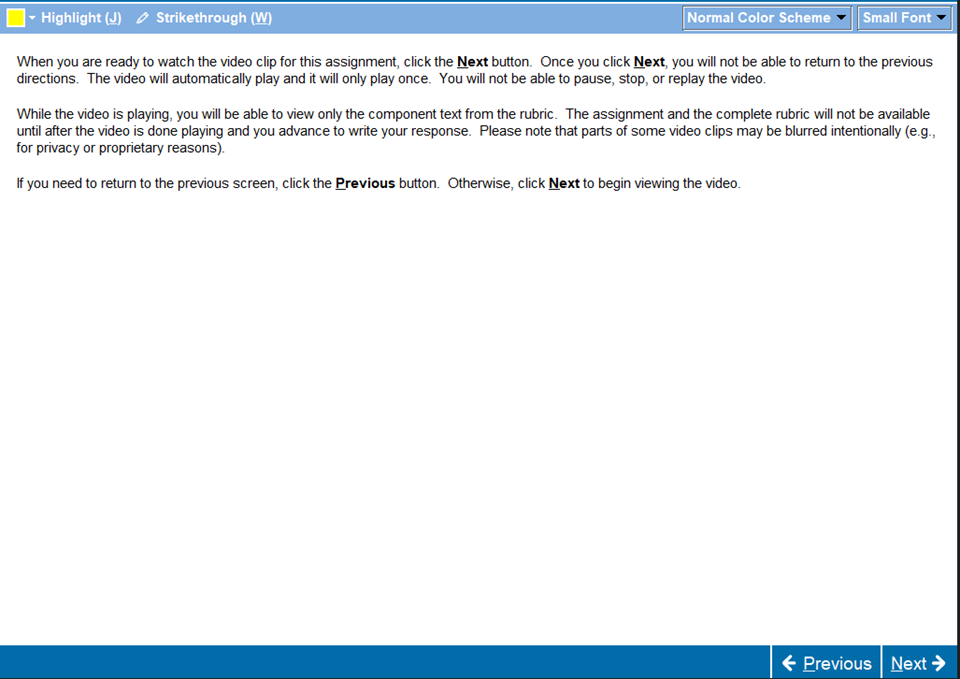 A screenshot from the school building leader computer based test showing the video observation directions. The content of the directions will be read below.
A screenshot from the school building leader computer based test showing the video observation directions. The content of the directions will be read below.
The text presented on this screen appears below.
When you are ready to watch the video clip for this assignment, click the Next button. Once you click Next, you will not be able to return to the previous directions. The video will automatically play and it will only play once. You will not be able to pause, stop, or replay the video.
While the video is playing, you will be able to view only the component text from the rubric. The assignment and the complete rubric will not be available until after the video is done playing and you advance to write your response. Please note that parts of some video clips may be blurred intentionally (e.g., for privacy or proprietary reasons).
If you need to return to the previous screen, click the Previous button. Otherwise, click Next to begin viewing the video.
When you are ready for the video clip to play, click Next as directed. You will move on to the screen shown below.
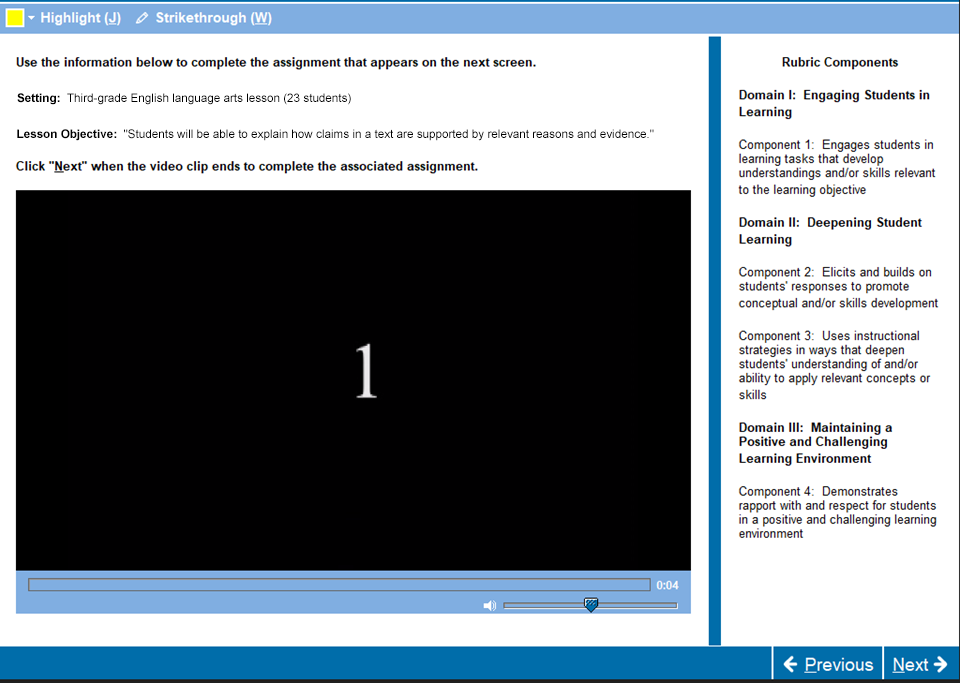 A screenshot from the school building leader computer based test showing a video player 5 second countdown at 1 and the classroom setting and lesson objective above the video player on the left side of the screen. The content of the classroom setting and lesson objective will be read below. The right side of the screen shows the rubric domains and components, which will be read below.
A screenshot from the school building leader computer based test showing a video player 5 second countdown at 1 and the classroom setting and lesson objective above the video player on the left side of the screen. The content of the classroom setting and lesson objective will be read below. The right side of the screen shows the rubric domains and components, which will be read below.
A five-second countdown will begin automatically on the video player. The classroom setting and lesson objective appear above the video player. The text appears below.
Setting: third-grade class English Language Arts lesson (23 students)
Lesson Objective: "Students will be able to explain how claims in a text are supported by relevant reasons and evidence."
The Rubric Components are presented in a pane on the right of the screen. The text appears below.
Rubric Components
Domain one : Engaging Students in Learning
Component 1: Engages students in learning tasks that develop understandings and/or skills relevant to the learning objective
Domain II: Deepening Student Learning
Component 2: Elicits and builds on students' responses to promote conceptual and/or skills development
Component 3: Uses instructional strategies in ways that deepen students' understanding of and/or ability to apply relevant concepts or skills
Domain III: Maintaining a Positive and Challenging Learning Environment
Component 4: Demonstrates rapport with and respect for students in a positive and challenging learning environment
The video clip will begin when the countdown ends. The clip will be approximately 15 minutes long, and you will not be able to pause, stop, or replay the video. During the video clip, the classroom setting and lesson objective will remain above the video player, and the Rubric Components will remain in the pane at the right of the screen.
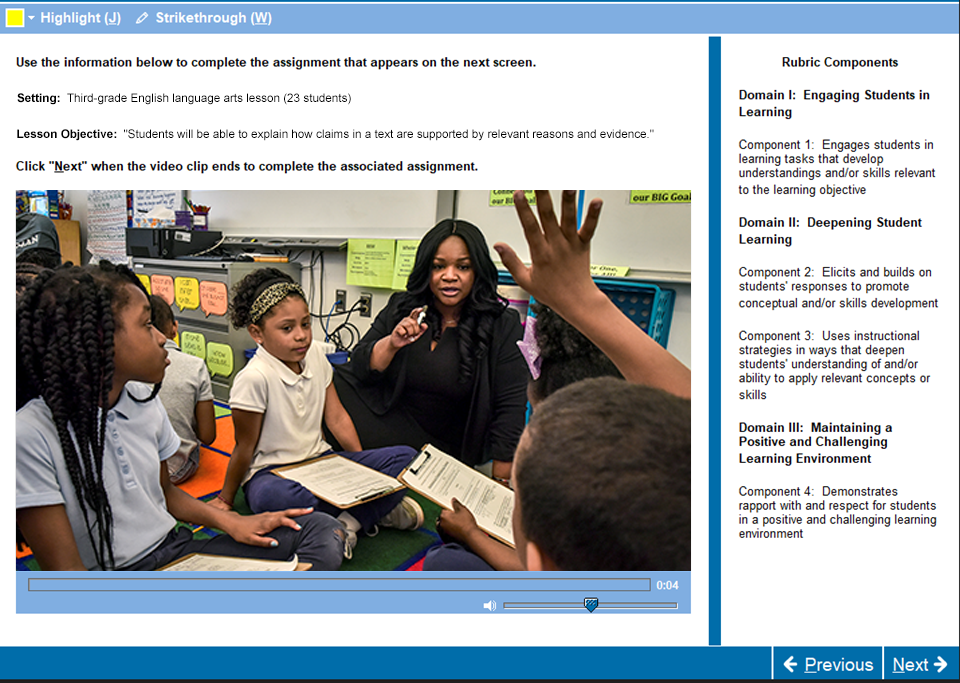 A screenshot from the school building leader computer based test. The left side of the screen shows the classroom setting and lesson objective content read above and a still image of a video of a teacher in a classroom engaged in a lesson with multiple students. The right side of the screen shows the rubric domains 1 through 3 and components 1 through 4 read in the Teacher Observation Rubrics section of this page.
A screenshot from the school building leader computer based test. The left side of the screen shows the classroom setting and lesson objective content read above and a still image of a video of a teacher in a classroom engaged in a lesson with multiple students. The right side of the screen shows the rubric domains 1 through 3 and components 1 through 4 read in the Teacher Observation Rubrics section of this page.
While watching the video clip, use the felt pen and erasable notebooklet provided at the test center to take notes regarding observable evidence of teacher�s level of competency, based on the Teacher Observation Rubric. When the video clip ends, click the Next button that appears on the bottom right of your screen.
Responding to Writing Assignment 1: Video Observation and Analysis
Complete the the Video Observation and Analysis Assignment on the screen shown below.
 A screenshot from the school building leader computer based test showing the response box on the left screen and the assignment on the right. The content of the assignment will be read below.
A screenshot from the school building leader computer based test showing the response box on the left screen and the assignment on the right. The content of the assignment will be read below.
Enter your response using the box on the left side of your screen. When the "Assignment" tab is clicked on the right side of your screen, the text that appears below will be presented.
Use the information that appears on the "Exhibit" tab to complete the assignment below.
Using the evidence you observed in the video and the Teacher Observation Rubric provided, prepare a 300 to 600 word evaluation of the observed teaching for your post-observation conference in which you:
- for each rubric component, cite observable, objective evidence from the video;
- assign a performance level (level 1 to level 5) for each rubric component, citing the evidence you identified;
- identify one significant strength exhibited in the teacher's performance, citing the relevant component(s) of the Teacher Observation Rubric and observable evidence as support; and
- identify one significant area for improvement exhibited in the teacher's performance, citing the relevant component(s) of the Teacher Observation Rubric and observable evidence as support.
When the "Exhibit" tab is clicked on the right side of your screen, the Teacher Observation Rubric will be presented. Please note that at the test center, you will need to use the scroll bar immediately to the right of the rubric to access all four rubric components: one for Domain one , two for Domain II, and one for Domain III.
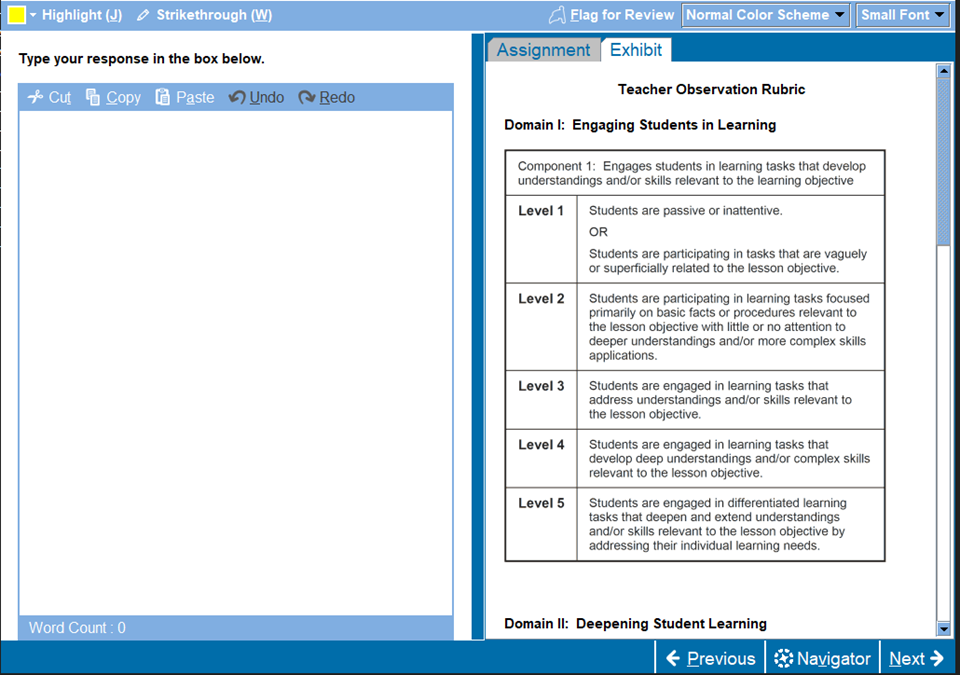 A screenshot from the school building leader computer based test showing the response box on the left screen and the exhibit on the right. The exhibit shows rubric domain 1 and component 1 read in the Teacher Observation Rubrics section of this page.
A screenshot from the school building leader computer based test showing the response box on the left screen and the exhibit on the right. The exhibit shows rubric domain 1 and component 1 read in the Teacher Observation Rubrics section of this page.
When you have completed your response, click the Next button that appears on the bottom right of your screen to move on to the next section of the test.
Performance Characteristics
The following characteristics guide the scoring of the response to the assignment.
| COMPLETENESS | The degree to which the response addresses all parts of the assignment |
|---|---|
| ACCURACY | The degree to which the response demonstrates the relevant knowledge and skills accurately and effectively |
| DEPTH OF SUPPORT AND UNDERSTANDING | The degree to which the response provides appropriate examples and details that demonstrate sound reasoning and reflects a strong understanding of the relevant knowledge and skills |
Score Scale
Scores will be assigned to the response to the assignment according to the following score scale.
| Score Point | Score Point Description |
|---|---|
| 4 | The "4" response reflects a thorough command of the relevant knowledge and skills. |
| 3 | The "3" response reflects a general command of the relevant knowledge and skills. |
| 2 | The "2" response reflects a limited command of the relevant knowledge and skills. |
| 1 | The "1" response reflects little or no command of the relevant knowledge and skills. |
| U | The response is unscorable because it is unrelated to the assigned topic or off-task, unreadable, written in a language other than English or contains an insufficient amount of original work to score. |
| B | No response. |
Acknowledgements
Kelly Harper, upper right, one of four finalists for the National Teacher of the Year, in her 3rd grade classroom at Amidon-Bowen elementary school, on April, 11, 2019 in Washington, DC. (Photo by Bill O'Leary/The Washington Post via Getty Images).
